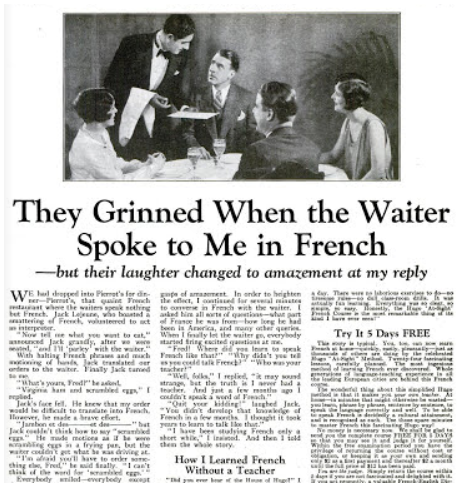Last Updated on 1 year by Greg Noland
John Caples – A Master of Copywriting
John Caples was an early pioneer in applying scientific methods to advertising. After graduation in 1924, Caples worked for the NY Telephone Co. as an engineer. Then for Certain-Teed Products Co., primarily performing clerical duties.
At the same time, he began taking writing courses at Columbia and set his sights on a career in copywriting. In 1925, Mr. Caples began his advertising career at Ruthrauff & Ryan, a leading mail-order company.
Caples learned quickly that the secret behind mail-order copywriting was…
“Responses show which ads are successful and which are not.”
So the wise copywriter learns what characteristics place an ad in the winning category.
“They laughed when I sat down at the piano, but when I started to play”

During his first year as a copywriter, Mr. Caples wrote one of the best-known direct-mail ads of all time.
It was for a home-study course offered by the U.S. School of Music.
The headline was, “They laughed when I sat down at the piano, but when I started to play!”
It was an overnight success.
Caples reworked that success into a subsequent ad for Doubleday, Page & Co:
“They grinned when the waiter spoke to me in French, but their laughter changed to amazement at my reply.”

This was another gem for Caples.
Following his success with R&R, Caples sought a position that would allow him to learn more about the industry.
So, in 1927, he joined Barton, Durstine & Osborn, which would later become Batten, Barton, Durstine & Osborn.
Caples’ third major ad success was written for the Phoenix Mutual Life Insurance Co. in 1928. Showing an old man relaxing with a fishing rod.
The headline was:
“To men who want to quit work some day.”

This ad, as well as “They Laughed,” appear in Julius Watkins’ book “The 100 Greatest Advertisements.”
Mr. Caples worked for BBDO for the remainder of his career. He became a VP in 1941 and later was named creative director.
One of my favourite quotes by Caples is:
“Every single element in an advertisement – headline, subhead, photo, and copy –
must be put there not because it looks good, not because it sounds good, but because testing has shown that it works best!”
So in honour of this great copywriter, here are 13 rules and guidelines for creating killer headlines that convert.
- The promise must be believable. Never make your claim bigger than your proof.
- Try to get self-interest into every headline you write. Promise a spectacular benefit that directly impacts your prospect.
- Use product news or announcements.
- Avoid headlines that provoke curiosity alone. Combine curiosity with news or self-interest.
- Avoid the negative. Show the positive angle.
- Suggest in your headline that here is a quick and easy way for the prospect to get what they want
- Do not make your headline so short that it fails to express your idea properly.
- Avoid “clever” headlines
- Avoid the meaningless headline
- Headlines that are merely a statement of fact are ineffective
- Your logo or a picture (with caption) can be considered as part of the headline
- Avoid the “hard-to-grasp” headlines that are not instantly crystal clear
- Do not run advertisements without headlines
I’d love to keep sharing copywriting gems, but the wifey is calling as it’s gym time…
Talk soon, my friend…

Yours for Bigger Profits, More Often,
Greg Noland
Red Scorpion’s Head Copywriter










